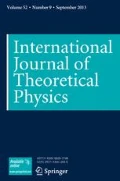Abstract
The present work is an attempt to investigate whether the evolutionary history of the Universe from the offset of inflation can be described by assuming the cosmic fluid to be an ideal gas with a specific gas constant but a varying negative absolute temperature (NAT). The motivation of this work is to search for an alternative to the “exotic” and “supernatural” dark energy (DE). In fact, the NAT works as an “effective quintessence” and there is need to deal neither with exotic matter like DE nor with modified gravity theories. For the sake of completeness, we release some clarifications on NATs in Section 3 of the paper.
Similar content being viewed by others
Notes
In SI units it is R = 8.314J/mol.K.
This implies that systems with NATs can never achieve thermodynamic equilibrium.
References
Sidharth, B.G.: The universe of fluctations. Int. J. Mod. Phys. A 13, 2599 (1998)
Riess, A.G., et al.: Astron J. 116(3), 1009 (1998)
Perlmutter, S., et al.: Astrophys. J. 517, 565 (1999)
Einstein, A.: Sitzun. Pre. Akad. Wiss. Berlin (Math. Phys.) 1917, 142 (1917)
Steinhardt, P.J.: Critical Problems in Physics. Princeton University Press, Princeton (1997)
Weinberg, S.: Rev. Mod. Phys. 61, 1 (1989)
Nojiri, S., Odintsov, S.D.: Phys. Rep. 505, 59 (2011)
Fujii, Y., Maeda, K.: The Scalar-Tensor Theory of Gravitation. Cambridge Monographs on Mathematical Physics. Cambridge University Press, Cambridge (2007)
Corda, C.: Int. J. Mod. Phys. D 18, 2275 (2009)
Bolejko, K., Célérier, M.N., Krasinski, A.: Class. Quantum Grav. 28, 164002 (2011)
Chakraborty, S., Saha, S., Corda, C.: Entropy 18(8), 287 (2016)
Zeldovich, I.B.: In: Confrontation of Cosmological Theories with Observational Data, pp. 329–333. D. Reidel Publishing Co., Dordrecht (1974)
Bilic, N., Tolic, D.: Phys. Rev. D 91, 104025 (2015)
Nunes, R.C., Barnoza, E.M. Jr., Abreu, E.M.C., Neto, J.A.: JCAP 08, 051 (2016)
Moradpour, H.: Int. J. Theor. Phys. 55, 4176 (2016)
Komatsu, N.: Eur. Phys. J. C 77, 229 (2017)
Moradpour, H., Heydarzade, Y., Darabi, F., Salako, I.G.: Eur. Phys. J. C 77, 259 (2017)
Moradpour, H., Nunes, R.C., Abreu, E.M.C., Neto, J.A.: Mod. Phys. Lett. A 32, 1750078 (2017)
Starobinski, A.A.: Pisma Zh. Eksp. Teor. Fiz. 30, 719 (1979)
Guth, A.: Phys. Rev. D 23, 347 (1981)
Vieira, J.P.P., Byrnes, C.T., Lewis, A.: J. Cosmol. Astropart. Phys. 1608, 060 (2016)
Elgaroy, O., Gron, O.: Entropy 15, 3620 (2013)
Lai, X.M., et al.: Acta Phys. Sin. 57(12), 7955 (2008)
Misner, C.W., Thorne, K.S., Wheeler, J.A.: Gravitation. Freeman and Company, San Francisco (1973)
Pavon, D.: private communication
Reif, F.: Fundamentals of Statistical and Thermal Physics. McGraw Hill, New York (1965)
Singh, R.B.: Introduction to Modern Physics. New Age International (2008)
Atkins, P.W.: The Laws of Thermodynamics: A Very Short Introduction. Oxford University Press, Oxford (2010)
Braun, S., et al.: Science 339(6115), 52 (2013)
Rahvar, S.: arXiv:physics/0603087 (2006)
Saha, S.: Europhys. Lett. 114, 59001 (2016)
Abraham, E., Penrose, O.: Phys. Rev. E 95, 012125 (2017)
Private communications with two unknown Reviewers
Ramsey, N.F.: Phys. Rev. 103, 2 (1956)
Tremblay, A.M.: Am. J. Phys. 44, 994 (1976)
Acknowledgments
Subhajit Saha was partially supported by SERB, Govt. of India under National Post-doctoral Fellowship Scheme [File No. PDF/2015/000906]. Anindita Mondal is thankful to DST, Govt. of India for providing Senior Research Fellowship. Christian Corda is supported financially by the Research Institute for Astronomy and Astrophysics of Maragha (RIAAM), Project No. 1/4717-16.
The authors thank two unknown Reviewers for useful comments and advices.
Author information
Authors and Affiliations
Corresponding author
Appendix A
Appendix A
Proposition
Negative absolute temperatures are hotter than positive absolute temperatures.
Proof
Consider two bodies (1 ∖ & 2) at different temperatures (T1∖ & T2)in contact with one another. Suppose there is a transfer of a small amountof heat Q from body 1 to body 2, which changes the entropy of body 1 by− Q/T1and that ofbody 2 by Q/T2, so that the total change in entropy is
The above quantity must be positive according to the second law. Now, if T1 < 0 and T2 > 0, then \(\frac {1}{T2}-\frac {1}{T1}>0\), which implies that body 1 (with a negative temperature) can transfer heat to body 2 (with a positive temperature), but not the other way around. Hence, negative absolute temperatures are hotter than positive absolute temperatures. □
Rights and permissions
About this article
Cite this article
Saha, S., Mondal, A. & Corda, C. Ideal Gas with a Varying (Negative Absolute) Temperature: an Alternative to Dark Energy?. Int J Theor Phys 57, 1417–1424 (2018). https://doi.org/10.1007/s10773-018-3670-1
Received:
Accepted:
Published:
Issue Date:
DOI: https://doi.org/10.1007/s10773-018-3670-1



